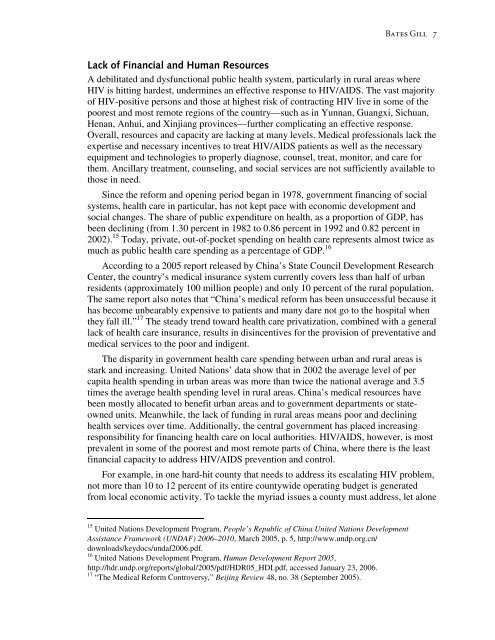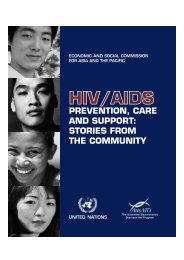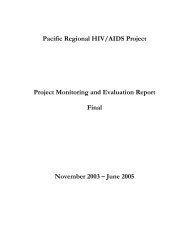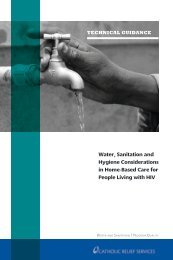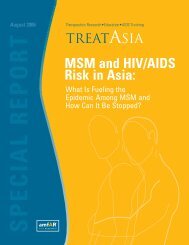Assessing HIV/AIDS Initiatives in China - Center for Strategic and ...
Assessing HIV/AIDS Initiatives in China - Center for Strategic and ...
Assessing HIV/AIDS Initiatives in China - Center for Strategic and ...
You also want an ePaper? Increase the reach of your titles
YUMPU automatically turns print PDFs into web optimized ePapers that Google loves.
Bates Gill 7<br />
Lack of F<strong>in</strong>ancial <strong>and</strong> Human Resources<br />
A debilitated <strong>and</strong> dysfunctional public health system, particularly <strong>in</strong> rural areas where<br />
<strong>HIV</strong> is hitt<strong>in</strong>g hardest, underm<strong>in</strong>es an effective response to <strong>HIV</strong>/<strong>AIDS</strong>. The vast majority<br />
of <strong>HIV</strong>-positive persons <strong>and</strong> those at highest risk of contract<strong>in</strong>g <strong>HIV</strong> live <strong>in</strong> some of the<br />
poorest <strong>and</strong> most remote regions of the country—such as <strong>in</strong> Yunnan, Guangxi, Sichuan,<br />
Henan, Anhui, <strong>and</strong> X<strong>in</strong>jiang prov<strong>in</strong>ces—further complicat<strong>in</strong>g an effective response.<br />
Overall, resources <strong>and</strong> capacity are lack<strong>in</strong>g at many levels. Medical professionals lack the<br />
expertise <strong>and</strong> necessary <strong>in</strong>centives to treat <strong>HIV</strong>/<strong>AIDS</strong> patients as well as the necessary<br />
equipment <strong>and</strong> technologies to properly diagnose, counsel, treat, monitor, <strong>and</strong> care <strong>for</strong><br />
them. Ancillary treatment, counsel<strong>in</strong>g, <strong>and</strong> social services are not sufficiently available to<br />
those <strong>in</strong> need.<br />
S<strong>in</strong>ce the re<strong>for</strong>m <strong>and</strong> open<strong>in</strong>g period began <strong>in</strong> 1978, government f<strong>in</strong>anc<strong>in</strong>g of social<br />
systems, health care <strong>in</strong> particular, has not kept pace with economic development <strong>and</strong><br />
social changes. The share of public expenditure on health, as a proportion of GDP, has<br />
been decl<strong>in</strong><strong>in</strong>g (from 1.30 percent <strong>in</strong> 1982 to 0.86 percent <strong>in</strong> 1992 <strong>and</strong> 0.82 percent <strong>in</strong><br />
2002). 15 Today, private, out-of-pocket spend<strong>in</strong>g on health care represents almost twice as<br />
much as public health care spend<strong>in</strong>g as a percentage of GDP. 16<br />
Accord<strong>in</strong>g to a 2005 report released by Ch<strong>in</strong>a’s State Council Development Research<br />
<strong>Center</strong>, the country’s medical <strong>in</strong>surance system currently covers less than half of urban<br />
residents (approximately 100 million people) <strong>and</strong> only 10 percent of the rural population.<br />
The same report also notes that “Ch<strong>in</strong>a’s medical re<strong>for</strong>m has been unsuccessful because it<br />
has become unbearably expensive to patients <strong>and</strong> many dare not go to the hospital when<br />
they fall ill.” 17 The steady trend toward health care privatization, comb<strong>in</strong>ed with a general<br />
lack of health care <strong>in</strong>surance, results <strong>in</strong> dis<strong>in</strong>centives <strong>for</strong> the provision of preventative <strong>and</strong><br />
medical services to the poor <strong>and</strong> <strong>in</strong>digent.<br />
The disparity <strong>in</strong> government health care spend<strong>in</strong>g between urban <strong>and</strong> rural areas is<br />
stark <strong>and</strong> <strong>in</strong>creas<strong>in</strong>g. United Nations’ data show that <strong>in</strong> 2002 the average level of per<br />
capita health spend<strong>in</strong>g <strong>in</strong> urban areas was more than twice the national average <strong>and</strong> 3.5<br />
times the average health spend<strong>in</strong>g level <strong>in</strong> rural areas. Ch<strong>in</strong>a’s medical resources have<br />
been mostly allocated to benefit urban areas <strong>and</strong> to government departments or stateowned<br />
units. Meanwhile, the lack of fund<strong>in</strong>g <strong>in</strong> rural areas means poor <strong>and</strong> decl<strong>in</strong><strong>in</strong>g<br />
health services over time. Additionally, the central government has placed <strong>in</strong>creas<strong>in</strong>g<br />
responsibility <strong>for</strong> f<strong>in</strong>anc<strong>in</strong>g health care on local authorities. <strong>HIV</strong>/<strong>AIDS</strong>, however, is most<br />
prevalent <strong>in</strong> some of the poorest <strong>and</strong> most remote parts of Ch<strong>in</strong>a, where there is the least<br />
f<strong>in</strong>ancial capacity to address <strong>HIV</strong>/<strong>AIDS</strong> prevention <strong>and</strong> control.<br />
For example, <strong>in</strong> one hard-hit county that needs to address its escalat<strong>in</strong>g <strong>HIV</strong> problem,<br />
not more than 10 to 12 percent of its entire countywide operat<strong>in</strong>g budget is generated<br />
from local economic activity. To tackle the myriad issues a county must address, let alone<br />
15 United Nations Development Program, People’s Republic of Ch<strong>in</strong>a United Nations Development<br />
Assistance Framework (UNDAF) 2006–2010, March 2005, p. 5, http://www.undp.org.cn/<br />
downloads/keydocs/undaf2006.pdf.<br />
16 United Nations Development Program, Human Development Report 2005,<br />
http://hdr.undp.org/reports/global/2005/pdf/HDR05_HDI.pdf, accessed January 23, 2006.<br />
17 “The Medical Re<strong>for</strong>m Controversy,” Beij<strong>in</strong>g Review 48, no. 38 (September 2005).


